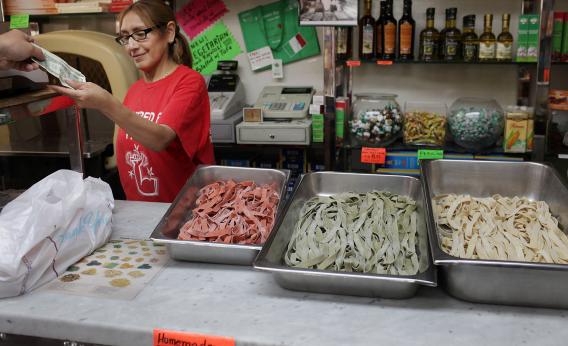Fresh pasta is even more delicious than dried pasta, and the ingredients you need to make it (basically flour and eggs) are cheap. So why aren’t we eating it all the time? Well, it’s much more efficient to make pasta in large factories and distribute it dried than to make it batch-by-batch in thousands of different restaurants. Nick Czap’s profile of pasta machine importer Emilio Mitidieri makes it clear that getting your restaurant kitchen equipped with the machines you need to make fresh pasta is a fairly complicated and expensive undertaking. The task seems to be complicated by the small-firm nature of the Italian economy. Rather than there being three or four giant manufacturers of pasta machines with highly efficient global supply chains and sales and support teams around the world, restaurateurs need to work with middlemen like Mitidieri on a much more individualized basis. There seem to be a lot of potential economies of scale not happening here.
But Czap buries the lede. Way down at the end of the piece we learn that there’s potentially a huge productivity revolution in the works here:
“Ninety-seven percent of the restaurant industry wouldn’t consider having a pasta machine, because they buy prepared pasta, or they seem intimidated by the machine,” he said, “but they all have a Hobart,” referring to the burly commercial mixer.
Sensing an untapped market, Mr. Mitidieri enlisted a machinist in Italy to develop a compact extruder and a sheeter that bolt onto a Hobart’s accessory socket. Capable of doing the work of stand-alone machines costing two-and-a-half times as much, these new devices may prove to be his silver (or in this case, stainless steel) bullet.
For the home kitchen, these kind of pasta attachments have long been available for KitchenAid’s stand mixers. My wife and I have both the roller/cutter attachment set and the extruder set, and it’s great. In a brilliant display of household complementarities, she makes the pasta and I make the sauce. Mitidieri’s proposal is essentially to replicate this same basic idea for the larger mixers that commercial kitchens use. The entire setup of a commercial mixer and pasta attachments would still be expensive, but the incremental cost of adding the attachments once you have the mixer is low.
And optimistically, a virtuous circle could arise. Bolt-on pasta machines will be much cheaper than stand-alones, which will encourage more restaurants to use them. And as fresh pasta begins to be served at a larger number of restaurants—and at cheaper, more broadly accessible restaurants—the share of people who appreciate the higher quality will grow. That means a larger market for the machines. And if the market for machines grows large enough, more economies of scale may emerge. Mitidieri may end up putting himself out of business if Hobart, with its large and established network, starts selling good pasta-making add-ons directly. But diners across the country will benefit.
Consider it another example of how we should take food service seriously as an economic sector. Productivity improvements in the manufacture of food-relevant capital goods could spark a widespread increase in living standards.
